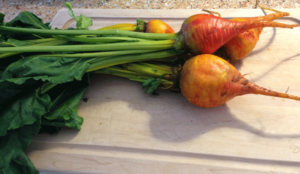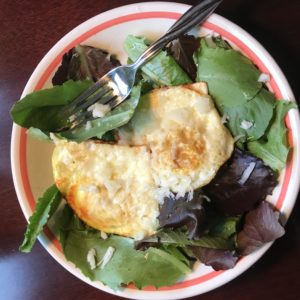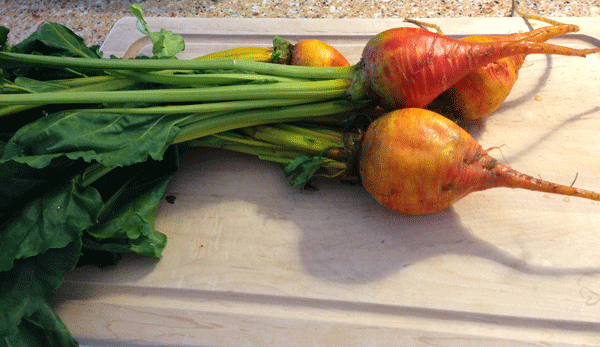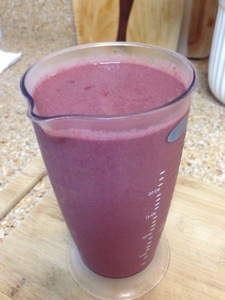2 over-easy eggs fried in duck fat, sprinkled with mineral salt and turmeric, and served over a bed of baby romaine with a spray of ACV and a few shreds of sheep’s milk cheese. 5-minute POWER BREAKFAST!!!
Category: Superfoods
Easy Garlic-Saving Trick
Years ago I was in the habit of buying those tiny trays of frozen crushed garlic. They disappeared from the stores for a while, and I forgot about them. When I decided to write this post for you, I did some digging and found out they still exist (at least online), but the ingredient label shows they also contain canola oil and salt, neither of which I want in my garlic. (Here’s why you may not want to consume canola oil.)
Anyway, I want to share with you this great garlic-saving trick I’ve been using a lot lately. If you like fresh garlic in your food but don’t like the sticky painful mess of peeling and chopping, then check this out.
When a recipe you have calls for, say one or two cloves of chopped garlic, make a whole head of it. It takes a little extra time but you gain overall efficiency in “mass production.”
- Break up the whole head of garlic by rolling it firmly around in a kitchen towel (these are my favorite). Go ahead and be aggressive with it, you’re going to chop it up anyway!
- Take a small knife and start chopping off those hard stubby ends. When you’re all done, take a large knife and press-smash the garlic with the side of the knife. The peels will start to pull away and fall off.
- Pull out the raw garlic cloves and either put them in a mini-chopper or set them aside in a bowl. Discard the detritus. Chop the garlic to desired size either by hand or in the mini-chopper.
- Set aside however much you need for tonight. Put a scoops of chopped garlic into the cells of a small ice cube tray , then wrap the tray in plastic and freeze.
- Once frozen, pop them out of the tray, and place in an air-tight container back in the freezer for later use.
Garlic’s health benefits are huge! A natural gut healer, anti-oxidant, and pre-biotic, you can’t go wrong with using a lot of garlic in your food.
Beets – A Lesson in Frugality
 Beets are the ultimate in nutritional usefulness. Each part of the beet is nutritionally useful, and even the few small parts you don’t want to eat can be fed to your garden in the form of compost.
Beets are the ultimate in nutritional usefulness. Each part of the beet is nutritionally useful, and even the few small parts you don’t want to eat can be fed to your garden in the form of compost.
Golden beets are beautiful and sweet, and according to some sources are much lower in starch than their red cousins. So if you are reducing starch in your diet for health reasons, golden beets are OK! Also, red beets are a pain with their sheer redness, which gets all over everything in your kitchen. I’ve already got stains on everything from all the turmeric I’m consuming, and add the red “blood” from beets and I’ve got sunset-colored cutting boards and wood-handled knives, not to mention my hands… Ah the price for health. But I digress…
Beets can be divided into three uniquely useful parts: the roots, the stems, and the leaves.
Roots: The root bulb is the most deliciously sweet part of the plant. The easiest way to cook the beet root is in foil packets on your grill (btw you can skip the peeling step and eat them with the peel on). Another way is to simply peel them and steam them, then drizzle with a little olive oil and salt and serve warm. Continue reading “Beets – A Lesson in Frugality”
Beet Ginger Smoothie
Yes, it tastes as good as it looks, and no added sugar!
1/2 C melon, chopped (or apple, including peel)
1 dozen red grapes
1/2 stalk celery with leaves
1 small piece of lime or lemon
1/2 fresh beet
1/2 banana Continue reading “Beet Ginger Smoothie”
30-Minute Salmon and Zucchini
Using a single frying pan, a spatula, a serving platter, and a few simple ingredients, you can whip up this delicious, nutritious meal of salmon and zucchini. Even with prep work it’s only 30 minutes from start to finish. Continue reading “30-Minute Salmon and Zucchini”
Quick Sautéed Kale and Carrots
This is the easiest way (IMO) to sauté kale so it’s not completely boring. Since kale can be somewhat bitter we add sweet veggies like carrots and onions to balance the flavors. Feel free to swap the carrots with parsnips, yellow or red bell peppers, or even red cabbage if you like.
Serves: 2 people with a bit left over
Hand on time: 10 minutes
Total time: 15 minutes
Ingredients
- 2 tsp olive or coconut oil
- 1 bunch kale
- 1 medium to large carrot
- 1/4 C chopped onion (optional)
- salt and pepper




